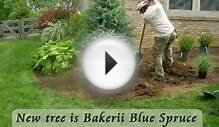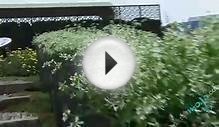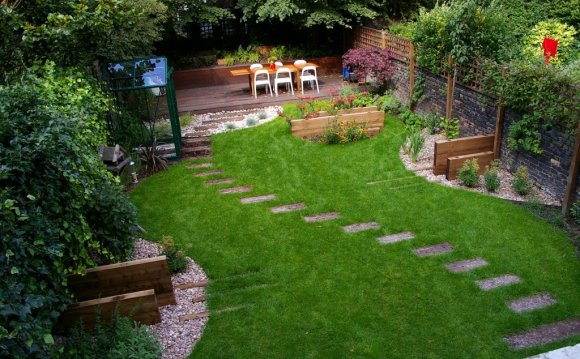
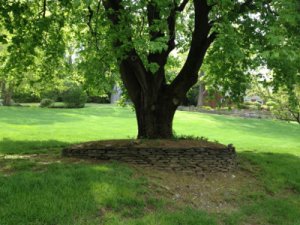 If you don’t want to doom a favorite tree, there’s one popular landscape feature you really should avoid: a raised bed built all around and partway up the trunk of that tree. It matters not what you plant in such a bed – flowers, ferns, shrubs or nothing at all. The effect will be the same: moist, airless soil against the trunk will rot the bark, which will invite insects and then rodents, which will further damage the bark, and soon the tree will be completely girdled so nutrients can no longer get drawn up to the twigs and leaves. And that’s it: the end of your tree.
If you don’t want to doom a favorite tree, there’s one popular landscape feature you really should avoid: a raised bed built all around and partway up the trunk of that tree. It matters not what you plant in such a bed – flowers, ferns, shrubs or nothing at all. The effect will be the same: moist, airless soil against the trunk will rot the bark, which will invite insects and then rodents, which will further damage the bark, and soon the tree will be completely girdled so nutrients can no longer get drawn up to the twigs and leaves. And that’s it: the end of your tree.
Pretty, but impractical in the long run.If you need to build a fence anywhere near a tree, please keep in mind one simple fact: trees grow. Not just taller. Not just fluffier with new leaves and branches. Every year, trees add a layer of new growth all around their trunks, just beneath the bark. This layer might be skinny or thick but, whatever its dimension, the new growth expands the diameter of the trunk outward in every direction for the entire height of the tree, and even at the base flare. So, what?
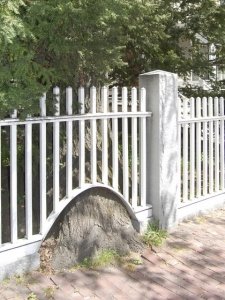 Mosses, bearberry, Canada mayflower and thyme.This landscape contains no lawn, and instead features a mosaic of ground-hugging plants, stepstones, and pea-stone paths of varying widths, meandering like a lazy river between islands and drifts of taller, flowering plants.
Mosses, bearberry, Canada mayflower and thyme.This landscape contains no lawn, and instead features a mosaic of ground-hugging plants, stepstones, and pea-stone paths of varying widths, meandering like a lazy river between islands and drifts of taller, flowering plants.
Created on a bare, sandy plateau that had been built out from a high, west-facing hillside in the Berkshire foothills of Massachusetts, the new landscape is surrounded by an old pine/hemlock/oak forest. It contains 37 plant species that were chosen for their ability to thrive in the site's dry soil, strong winds and hot afternoon sun, and to be a natural extension of the enclosing woodland. Almost 90% of the plants are native species, and 70% are locally indigenous.They include:
 When we plant non-native species in our gardens and yards, these plants have tremendous potential to cause unexpected harm. Here's a story about a big one that affects us all.
When we plant non-native species in our gardens and yards, these plants have tremendous potential to cause unexpected harm. Here's a story about a big one that affects us all.
"Florida’s citrus industry is grappling with the most serious threat in its history: a bacterial disease with no cure that has infected all 32 of the state’s citrus-growing counties.
At a neighborhood party last week, I heard two comments that brought me up short, and reminded me again about a basic conundrum in my work.
A landscape doesn't need plants, to be a landscape. First comment: “Oh yeah, I know that place. There’s no landscape there.” This from a friend after I told him the location of a property I had been hired to design.
Although I completely disagreed, I knew what he meant. Most people think “landscape” means “plants.” Beyond having a lot of lawn, this property’s front, side and back yards are empty of plants. Ergo: no landscape there. Yet the property is full of problems, big problems, problems that plants alone won’t fix.
Before you carry on with all the same old arrangements in the yard… or before you make a bunch of changes you’ve been dreaming about all winter long…this is a perfect time to slow down and consider how much energy you could conserve in your gardens and grounds. If you’re interested in shrinking your carbon footprint, or you just want to save some money, here are five simple suggestions to help you go “energy-wise” outside the house.
When the sugar maples burst into their yellow-green froth, when spent white petals of shadblow flowers waft past on a breeze, and while the forest floor is still brown duff, this is a good time to see one of the most common plants in nature, a dominant understory species that many people have never noticed, seemingly as abundant as ants, the tiny plant named for the month in which it blooms: Canada Mayflower (Maianthemum canadense).

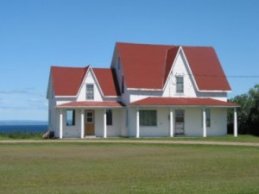
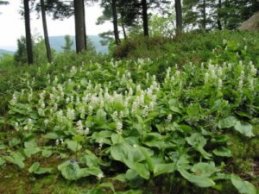
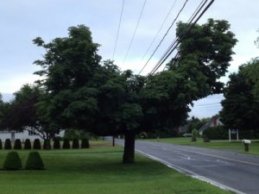
YOU MIGHT ALSO LIKE
